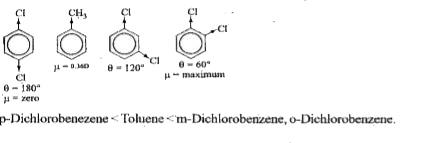Arrange the following compounds in the order of increasing dipole moment : toluene (I), m-dichlorobenezene (II), o-dichlorobenezene (III), p-dichlorobenezene (IV). Solution in Malayalam
I lt IV lt II lt III
IV lt I lt II lt III
IV lt I lt III lt II
IV lt II lt I lt III
The correct Answer is:B
Topper's Solved these Questions
- BOOK - BRILLIANT PUBLICATIONCHAPTER - CHEMICAL BONDINGEXERCISE - LEVEL-II (ASSERTION-REASON TYPE)20videos
CHEMICAL BONDING
- BOOK - BRILLIANT PUBLICATIONCHAPTER - CHEMICAL BONDINGEXERCISE - QUESTIONS6videos
CHEMICAL BONDING
- BOOK - BRILLIANT PUBLICATIONCHAPTER - CHEMICAL BONDINGEXERCISE - LEVEL-I120videos
CHEMICAL BONDING
- BOOK - BRILLIANT PUBLICATIONCHAPTER - CHEMICAL AND IONIC EQUILIBRIUMEXERCISE - Level - III (Linked Comprehension Type Questions)1videos
CHEMICAL AND IONIC EQUILIBRIUM
- BOOK - BRILLIANT PUBLICATIONCHAPTER - CHEMICAL BONDING AND MOLECULAR STRUCTUREEXERCISE - QUESTION (LEVEL -ll)42videos
CHEMICAL BONDING AND MOLECULAR STRUCTURE
Similar Questions
In the following question, an Assertion (A) is followed by a corresponding Reason (R). Use the following keys to choose the appropriate answer.
Assertion : In case of (CH3)3N geometry is pyramidal, but in case of (SiH3)3N it is planar.
Reason : The maximum covalency of Si is six but that of C is four. : If both (A) and (R) are correct and (R) is the correct explanation of (A)., If both (A) and (R) are correct, but (R) is not the correct explanation of (A)., If (A) is correct, but (R) is incorrect., If both (A) and (R) are incorrect.09:34View SolutionThe dipole moment of water is 1.84D and dipole moment of O-H bond is 1.5D. Calculate the H-O-H bond angle in water.
04:40View SolutionMgSO4 is soluble while BaSO4 is insoluble in H2O. This is because
06:12View SolutionThe degre of dissociation of weak electrolyte is inversely proportional to the same square root of concentration. What is called Ostwald's dilution law.
α=√Kac As the temperature increases, degree of dissociation will increase.
α1α2=√Ka1Ka2 if concentration is same. α1α2=√c2c1 if acid is sam.
For two monobasic acids HA1 and HA2 at the same concentration α1 and α2 are in ratio of 1:2. Ka1=2×10−4. What will be Ka2 ? 8×10−4, 2×10−4, 4×10−4, 1×10−407:56View SolutionWhich of the following species are hypervalent ?
(l) ClO−4
(ll) BF3
(lll) SO2−4
(lV) CO2−306:32View SolutionArrange the following compounds in order of increasing dipole moment . Toluene (I) m-dichlorobenxene (II) o-dichlorobebncene (III) . P-dichlorobennzebe (IV) .
04:06View SolutionArrange the following compounds in order of increasing dipole moment:
(i) toluene (ii) m-dichloro benzene
(iii) o-dichloro benzene (iv) p-dichloro benzene06:12View SolutionArrange the following compounds in order of ltbr> Increasing dipole moment Toluene (I), m-dichlorobenzene (II), o-dichloro-benzene (III) , p-dichlorobenzene (IV)
02:20View Solutionनिम्नलिखित यौगिकों को द्विध्रुव आघूर्ण (dipole moment) के बढ़ते हुए क्रम में व्यवस्थित कीजिए: टॉलूईन (I), m-डाइक्लोरोबैंजीन (II), o-डाइक्लोरोबैंजीन (III) तथा p-डाइक्लोरोबैंजीन (IV)
07:32View SolutionArrange the following compounds in order of increasing dipole moment:
(I) Toluene
(II) m-Dichlorobenzene
(III) o-Dichlorobemzene
(IV) p-Dichlorobenzene06:23View SolutionFour compounds, Toluene (I), o-dichlorobenzene (II), m-dichlorobenzene (III) and p-dichlorobenzene (IV) are arranged in the order of increasing dipole moment. The correct order is
03:32View SolutionArrange the following compounds in order of increasing dipole moment, Ethylbenzene (I), m-dichlorobenzene (II), o-dichlorobenzene (III), p-dichlorobenzene (IV)
View Solutionटॉलुईन (I), m- डाइक्लोरोबेन्जीन (II), o- डाइक्लोरोबेन्जीन (III) तथा p- डाइक्लोरोबेन्जीन (IV) के घटते हुए द्विध्रुव आघूर्ण का सही क्रम है
03:54View SolutionArrange the following compounds in order of increasing dipole moment :
Toluene (I), m-dichlorobenzene (II),
o-dichlorobenzene (III), p-dichlorobenzene (IV)06:45View SolutionArrange the following compounds in order of increasing dipole moment, Toluene (I), m-dichlorobenzene (II).o-dichlorobenzene (III) and p-dichlorobenzene (IV).
04:58View Solution


